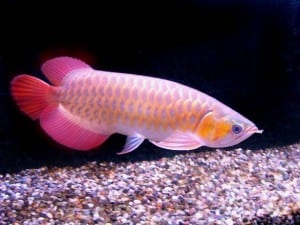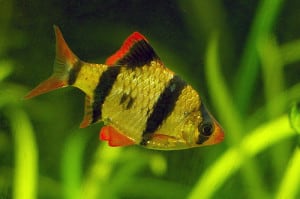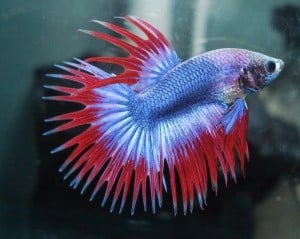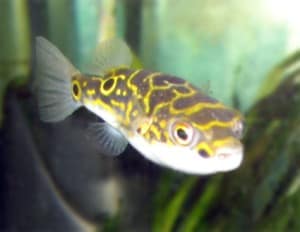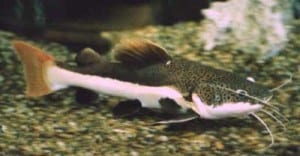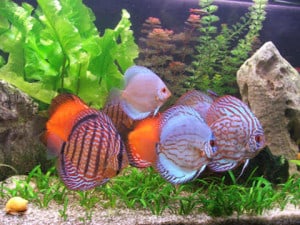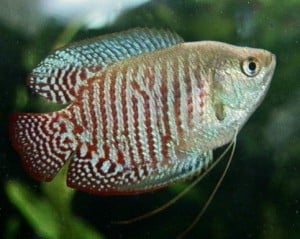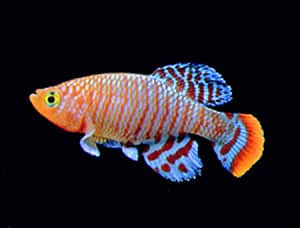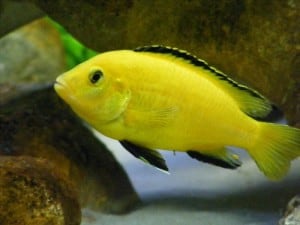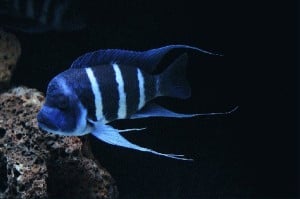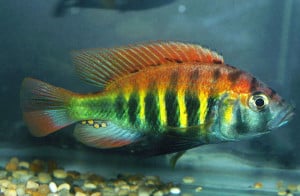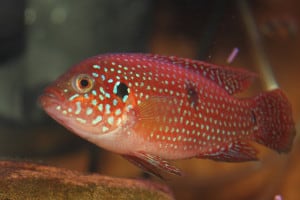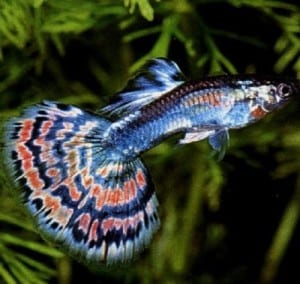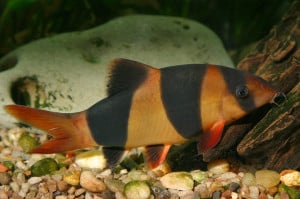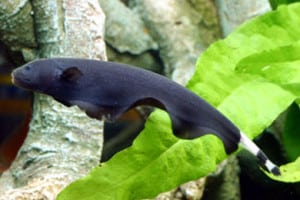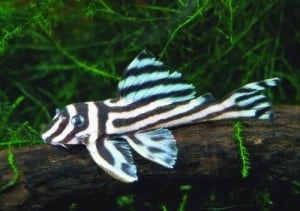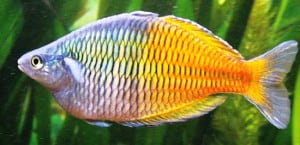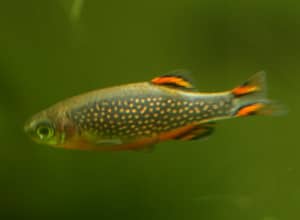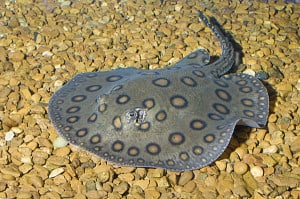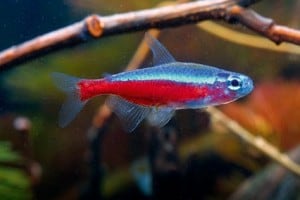Tropical fish profiles explaining the origins of tropical fish and the best ways to care for them and keep them in the home aquarium as well as tips on breeding and how to tell the sex of your tropical fish. The categories below give an overview of the types of fish and we are continuing to update the database of fish in each area to ensure you can see the widest range of fish available for each type.
Alternatively if you just want to browse then take a look at All Tropical Fish Profiles.
American Cichlids
America offers a vast range of tropical fish from the cichlid family. These fish vary from those in the Amazon river in South America to cichlids originating in north and central America.
Due to the vast popularity of Discus cichlids we have given them their own section even though they are technically an American Cichlid.
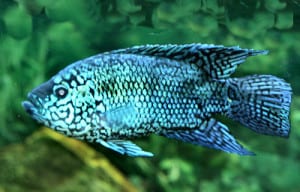 Arowana
Arowana
Arowana are a popular aquarium fish that often are seen to have special cultural significance in areas influenced by Chinese culture. The name dragonfish stems from their resemblance to the Chinese dragon. This popularity has had both positive and negative effects on their status as endangered species.
The Arowana tropical fish, as you can see from the fish profiles we have put together will all grow to become large or “monster” fish and as such should only be kept in large well filtered aquariums.
 Barbs
Barbs
A barb is one of various ray-finned fish species in a non-phylogenetic group, with members in the family Cyprinidae, and especially the genera Barbus and Puntius, but many others also. They were formerly united with the barbels in the subfamily Barbinae, but that group is paraphyletic with the Cyprininae. If the Labeoninae are recognized as distinct, many small African “barbs” would probably, however, warrant recognition as a new subfamily.
This Barbs tropical fish profiles section covers everything you need to know about keeping Barb tropical aquarium fish and how to care for them to ensure they have a healthy and long life. These are often kept in community or planted fish tanks although the slightly more aggressive nature of the Barb fish group is often seen as a reason to keep these away from tanks with smaller community fish such as tetras. If you delve deeper in to each fish profile we have put together you will see the compatibility with other fish as well as recommended tank set up and breeding information to help you choose the right fish for you aquarium.
 Bettas
Bettas
Betta tropical fish profiles covers a small genus of fish however there are many different varieties available. Due to the extremely colourful nature of the Betta fish there are many “man made” variants to suit various tastes. Often the Betta is more commonly known as the Japanese fighting fish (or Siamese fighting fish) however they are far from fighters when comparing to many cichlid fish. However it is recommended (as with cichlids) that you ensure the right male to female ratio is kept and in the right size tank, if you take a look at the fish profiles we have put together you can be sure to receive some good advice on the best scenario that suits you.
It is however common, unless you intend to breed these fish, to keep a single male Betta fish, and often in it’s own tank however with the right timid fish and enough hiding places the Japanese fighting fish can be kept in a community fish tank.
 Brackish
Brackish
Brackish tropical fish are often overlooked as a variant which are seen as middle ground between freshwater tropical fish and marine fish. This is due to some of the fish being able to live in both freshwater and salt water. We have put together these Brackish Tropical Fish profiles to highlight the ease of keeping this type of fish in the home aquarium and what care must be taken with the parameters you actually need so that it is no longer an area of fish keeping which is overlooked.
 Catfish
Catfish
Catfish covers a vast range of tropical fish which are normally quite lively and tend to be bottom feeder fish. They are named catfish due to their barbels which resemble a cats whiskers. Most fish tanks will house at least one catfish, this is due to them being favoured by most aquarists as interesting to watch and active fish as well as being different to other types of tropical fish. You can see from the profiles of catfish in this section that they vary greatly in size, shape and behaviour and although generally not overly easy to breed, some breeding information is given for each species.
The largest species of Catfish is the Pleco and as such we have put these in a different category so if you are looking for them please go to the Pleco Tropical Fish Profiles category.
 Discus
Discus
Although technically an American cichlid, the Discus cichlid has a huge fan base and type of aquaria of its own so we thought it only fitting to give these beautiful peaceful community fish a category of their own.
Gourami
Gouramis or gouramies are a family, Osphronemidae, of freshwater perciform fishes. The fish are native to Asia, from Pakistan and India to the Malay Archipelago and north-easterly towards Korea. The name “gourami”, of Javanese origin, is also used for fish of the families Helostomatidae and Anabantidae. Gourami is already plural in its original language.
These tropical fish profiles of Gourami freshwater fish aim to help you make the right choice of fish for your aquarium and the majority of Gourami tropical fish are kept in planted or community aquariums. Generally speaking the Gourami fish species is quite placid and can exhibit some beautiful colours.
 Killifish
Killifish
A killifish is any of various oviparous (egg-laying) cyprinodontiform fish (including families Aplocheilidae, Cyprinodontidae, Fundulidae, Nothobranchiidae, Profundulidae, Rivulidae and Valenciidae). Altogether, there are some 1270 different species of killifish, the biggest family being Rivulidae, containing more than 320 species. Although killifish is sometimes used as an English equivalent to Cyprinodontidae, some species belonging to that family have their own common names, such as the pupfish and the mummichog. The name killifish is derived from the Dutch word “kilde”, meaning small creek, puddle. Because of living in ephemeral waters, the eggs of most killifish can survive periods of partial dehydration. Like seeds, the eggs can be sent by mail without water and this often how Killifish are sold.
These Killifish tropical fish profiles cover the most common Killifish you are likely to come across and show the different variants available.
 Lake Malawi Cichlids
Lake Malawi Cichlids
Tropical Fish Profiles of cichlids from Lake Malawi in Africa. With a claim to fame as the ninth largest lake in the world, Lake Malawi is also the third largest and second deepest lake in Africa, situated at far south of the East African Rift system. It is home to more than 1000 species of cichlids so we will cover as many as possible and those most commonly known in the trade of ornamental fish keeping.
The majority of cichlids from Lake Malawi can be broken down in to three different types, the Aulonocara (Peacocks), Haplochromis (Haps) and Mbuna. It is quite common to keep the Aulonocara cichlid together with Haps as these both have the same diet and tend to swim more in open water although rock work is still essential in the aquarium. Mbuna are primarily a vegetarian so they get their nutrition from grazing on rocks, as such feeding them some of the essentials that the Peacock’s and Haplochromis require can lead to problems.
Malawi Fish Tanks are often thought of as the closest thing to Marine fish keeping due to the rock work required and the stunning vibrant colours that these fish can bring to the home aquarium.
 Lake Tanganyika Cichlids
Lake Tanganyika Cichlids
Tropical Fish Profiles from Lake Tanganyika in Africa. Like all rift valley cichlids, the Tanganyika cichlids generally like to be homed in a rocky environment however, unlike Lake Malawi cichlids, there are many different shapes and sizes of Lake Tanganyika Cichlid. There are more considerations and variations of Lake Tanganyika cichlid and should often be kept in a species only tank due to hugely varying temperaments and diets. One of the most common Lake Tanganyika cichlid is the Tropheus which generally should be kept in a species only tank.
Lake Tanganyika is estimated to be the second largest freshwater lake in the world by volume, and the second deepest as well as being the longest in the world. It spans 4 countries, Tanzania, the Democratic Republic of the Congo, Burundi, and Zambia and eventually, after running out through the Congo, ends up in the Atlantic Ocean.
These tropical fish profiles of Lake Tanganyika cichlids aim to help you work out the type of fish which are most compatible with each other as well as hints and tips on breeding them successfully.
 Lake Victoria Cichlids
Lake Victoria Cichlids
Like Lake Malawi and Lake Tanganyika, Lake Victoria is based in the great African Rift Valley in Africa. With a surface area of 68,800 square kilometres (26,600 sq mi), Lake Victoria is Africa’s largest lake by area, and it is the largest tropical lake in the world. Lake Victoria is the world’s 2nd largest freshwater lake by surface area.
There is a great range of extremely colourful cichlids from Lake Victoria and are often kept with Lake Malawi or Lake Tanganyika cichlids due to the environment required to keep them being the same. These Lake Victoria Cichlid Tropical Fish Profiles will give you a guide on how to best keep the cichlids including the best fish tank set up, compatible tank mates as well as how to breed them in the home aquarium.
 African Cichlid (Non-Rift)
African Cichlid (Non-Rift)
Although when most people refer to African cichlids they will normally come from the rift valley lakes, primarily Lake Malawi, Lake Tanganyika and Lake Victoria. There are also varieties of cichlids from other parts of Africa which are not native to the main rift valley lakes and are often mistaken as being native to South America.
Fish profiles of African non-rift cichlids are covered here to ensure you can make the right choice of fish to keep and ensure they have the best environment to live in the home aquarium.
 Livebearers
Livebearers
Live-bearing aquarium fish, often simply called livebearers, are fish that retain the eggs inside the body and give birth to live, free-swimming young. These are one of the easiest types of tropical fish to breed and it is so satisfying and amazing to watch this happen. As part of these livebearer tropical fish profiles you can not only read about the best environment required in order to help these fish breed but also which fish they are compatible with and typical tank set up as well as optimum water parameters.
The main types of livebearer tropical fish are the Platy, Molly and Guppy. All of which are available in an array of different colours to suite different tastes although it is quite common for the females to exhibit less colour than the males, this is also explained in more detail in each individual fish profile.
 Loaches
Loaches
Loach tropical fish profiles area covers the sub group of Cypriniformes which are an order of ray-finned fish. Loaches are commonly bottom dwelling fish which will normally sift through the sand and some types will even act as a clean up crew for you, eating left over food or in some cases, unwanted snails.
 Oddballs
Oddballs
Oddball tropical fish are just that, they are oddballs and do not generally fit under any other category. With many different shapes and sizes as well as habitats they can often be one of the most interesting of tropical fish to keep.
These fish profiles of oddballs explain the best water parameters to keep them in as well as tank set up and other tank mates which you could keep with them. We have tried to list as much additional information too so you can impress your friends and family when they ask about the special fish in your aquarium!
 Pleco
Pleco
The largest species of catfish are the Plecostomus or as they are more commonly known – Pleco. Due to the huge range of different types of Pleco we wanted to give them their own category away from Catfish as some aquarists will only keep Pleco tropical fish.
Coming from all different parts of the world the Pleco is normally seen in most types of tropical fish tank and will generally be seen as a cleaner due to their natural feeding habit of scraping and eating algae from surfaces. Often Pleco tropical fish will help keep algae levels down on the glass too which means less cleaning for you!
 Rainbows
Rainbows
The rainbowfish are a family (Melanotaeniidae) of small, colourful, freshwater fish found in northern and eastern Australia, New Guinea, islands in Cenderawasih Bay, and the Raja Ampat Islands.
These Rainbow fish profiles show the best water conditions and fish tank set up to keep them in, although it is common to have rainbow fish in a community or planted freshwater aquarium. We have also listed in these fish profiles the best tank mates for rainbow fish as well as breeding and sexing information.
 Rasboras
Rasboras
A rasbora is a member of a group of small minnow-type fish in the family Cyprinidae (carps). Fish from genera such as Boraras, Microrasbora, Rasbora and Trigonostigma are commonly referred to as rasboras. The genus Microrasbora may be more closely related to danios than other genera in this group, while the genera Boraras and Trignonstigma were split from Rasbora. Currently, the genus Rasbora remains the largest one which can be found in Southeast Asia and Africa.
These tropical fish profiles for the Rasbora group of fish go in to detail about the prime conditions in which to keep these fish in the home aquarium.
 Stingray
Stingray
Often Stingray fish are thought of as marine fish however there are many different variants of freshwater stingray which are readily available in the ornamental fish keeping hobby. Although the pups are generally not that big, it is often a very large aquarium that is required to ensure they are given the best home within your home. Our Stingray fish profiles list the minimum aquarium size recommended to keep each type of freshwater stingray as well as a typical tank set up and tank mates which might lead to a very interesting and pleasing fish tank.
 Tetra
Tetra
The tetra is often the iconic fish associated with keeping tropical fish and will often be one of the first types of fish you might keep in the home aquarium. These are recommended as such due to not growing to be huge fish yet from an early age they exhibit vibrant colours and are generally always active. Given a big enough tank most types are likely to shoal giving you a fascinating home aquarium.
We have put together some profiles of tetra tropical fish in this section so you can see the wide range of varieties available and how best to keep and care for them in your fish tank.

